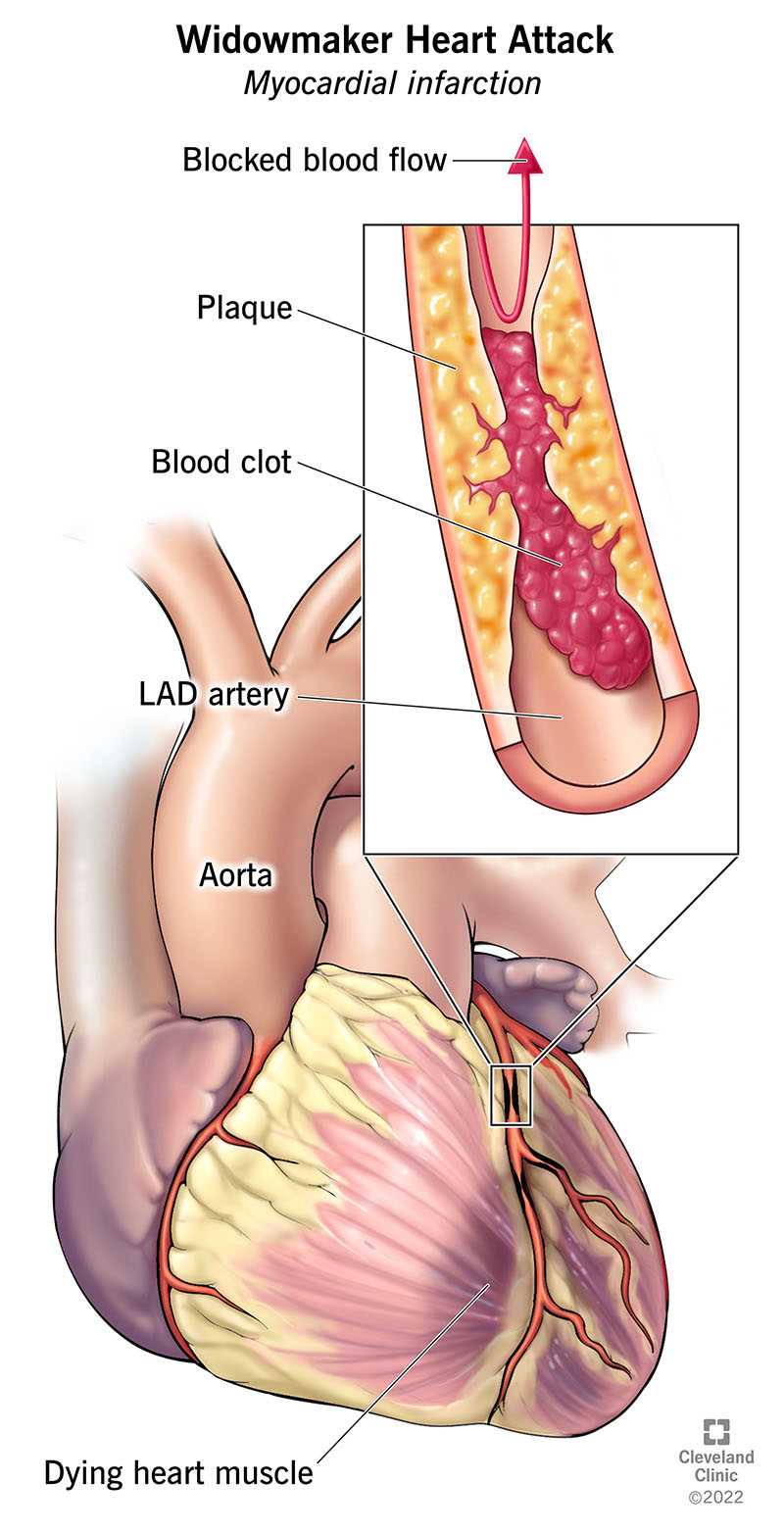A widowmaker heart attack happens when you have a blockage in the biggest artery in your heart. That means blood can’t move through your left anterior descending (LAD) artery, which provides 50% of your heart muscle’s blood supply. Immediate treatment is crucial for a chance at survival.
Advertisement
Cleveland Clinic is a non-profit academic medical center. Advertising on our site helps support our mission. We do not endorse non-Cleveland Clinic products or services. Policy

A widowmaker heart attack is a type of heart attack in which you have a full blockage in your heart’s biggest artery. This artery, the left anterior descending (LAD) artery, sends oxygen-rich blood to your heart’s left ventricle. This lower chamber pumps oxygen-rich blood to your aorta, which sends it to your body.
Advertisement
Cleveland Clinic is a non-profit academic medical center. Advertising on our site helps support our mission. We do not endorse non-Cleveland Clinic products or services. Policy
Healthcare providers call a heart attack a “myocardial infarction,” which means you don’t have enough blood going to your heart muscle (myocardium). Your heart muscle can die without enough blood flow.
A heart attack is a medical emergency. Call 911 or your local emergency number if you think you’re having a heart attack.
A widowmaker heart attack is immediately life-threatening. This is because the LAD provides about 50% of your heart muscle’s blood supply.
The name sounds like a widowmaker heart attack only affects men. However, women can have this type of heart attack, too.
Heart attack risk increases when you:
Widowmaker heart attack symptoms include:
Call 911 or your local emergency number if you have these symptoms.
Atherosclerosis, a buildup of cholesterol and other deposits in your LAD artery, causes a widowmaker heart attack. A blood clot can also block your LAD artery and cause a widowmaker heart attack.
Advertisement
A provider will use several tests to diagnose a widowmaker heart attack, such as:
A provider will use these widowmaker heart attack treatments:
You may be in the hospital for two to four days after a widowmaker heart attack. Some people need to stay longer, especially if they have complications.
Some drugs for a widowmaker heart attack can cause bleeding.
People who receive a stent to keep their LAD artery open need to take medicine to prevent blood clots.
A coronary artery bypass graft operation carries a risk of stroke, another heart attack or death.
You’ll need about eight weeks for widowmaker heart attack recovery. Some people can return to work in two weeks. Others need up to three months to recover. If your job is physically demanding, it may be helpful to change to a less demanding job.
Fifty percent of heart attack deaths happen in the first few hours after symptoms start. But many people who live several days after a heart attack can recover fully. However, 10% don’t make it through the first year after a heart attack.
You can reduce your risk of a widowmaker heart attack in many ways, such as:
If you’ve had a heart attack, you may need to make some changes in your life to prevent another one. You can:
Be sure to go to all of your scheduled appointments with your healthcare provider. They’ll want to see how you’re progressing in your recovery. Appointments are also a way to learn if you need a different dose of any of the medicines you’re taking.
Call 911 or your local emergency number right away if you’re having symptoms of another heart attack.
Questions you may want to ask your provider include:
Calling for help right away is crucial if you think you’re having a heart attack. The faster you get help, the more heart muscle a provider may be able to save. Paramedics can start treating you while you’re on the way to the hospital, so call 911 instead of having a friend or relative drive you to the hospital.
Advertisement
When you need treatment for coronary artery disease, you want expert care. At Cleveland Clinic, we’ll create a treatment plan that’s personalized to you.

Last reviewed on 12/06/2022.
Learn more about the Health Library and our editorial process.